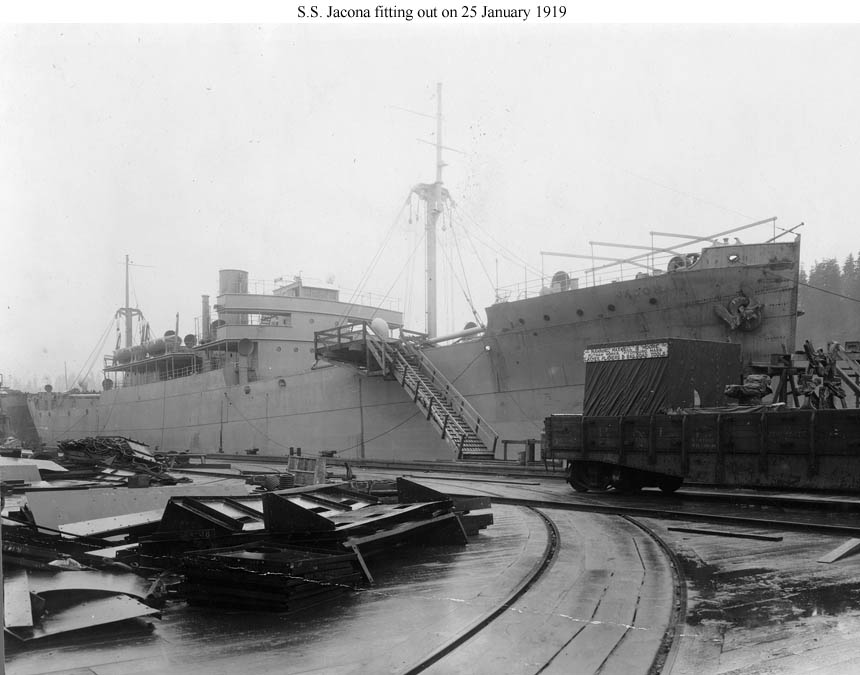EFC Design 1014 (Cascade type): Notes & Illustrations

Click here for a larger and more complete plan: Sheet 1
Click on the photographs below to prompt larger views of the same images.
|
Notes: Design 1014 appears to have originated with three 7500 deadweight ton freighters, Golden Gate, Key West, and Storviken (yard nos. 88-90), that were ordered in 1916 from Seattle's original steel shipyard, the Seattle Construction and Dry Dock Co., and delivered to Norwegian owners in May-July 1917. This yard then received orders for three more 7500 dwt ships for Norway, one for France, and six for Britain, all of which along with one for the yard's account were later requisitioned for U.S. use by the Shipping Board on 3 August 1917. In 1916 the William H. Todd Corporation of New York purchased the Seattle company, apparently without changing its name. Todd then built a new yard, the Todd Dry Dock & Construction Co., at Tacoma, Washington, to which the U.K. orders and the yard account ship were transferred from Seattle. On 5 June 1917 the Seattle Construction and Dry Dock Co. received an EFC contract for ten more ships of this 7500 dwt type (EFC Hulls 105-114), now officially called Design 1014. In 1918 Todd shifted its repair business in Seattle to Harbor Island near to the Ames and Duthie shipyards, concentrated its construction business at the Tacoma yard, and sold the original Seattle shipyard to the Shipping Board who on 1 June 1918 handed it over to its neighbor, the Skinner & Eddy Corp., for operation as its Shipyard No. 2. On 31 August 1918 the Todd Dry Dock & Construction Co. received an EFC order for 24 more ships of this type (EFC Hulls 2629 to 2652), of which the last 12 were cancelled after the war. Each ship beginning with the British order had two builder's yard numbers, one at Seattle and one at Tacoma, leading to later confusion as to which ship was built in which yard. Construction dates and press reports indicate that the Norwegian and French orders and EFC Hulls 107-110 were built at Seattle, while the British orders, EFC 105-106, 111-114, and 2629-2640 were built at Tacoma. The name associated with the design, "Cascade," was the American name given to the last ship in the British order. Requisitioned Sisters: These included one French and three Norwegian ships at Seattle (Yard nos. 92 to 95) and six British ships and one ship for the yard at Tacoma (Tacoma yard nos 1-7). All are covered in the Requisitioned Ships portion of the McKellar list. Yard numbers: For reference the correlations between the Seattle and Tacoma yard numbers were: Seattle 92-95 (no Tacoma numbers); Seattle 96-99 = Tacoma 3, 1, 5, and 6; Seattle 100 = Tacoma 30 (USS Omaha); Seattle 101-105 = Tacoma 2, 4, 7, 20, and 21; Seattle 106-107 = Tacoma 31-32 (USS Milwaukee and Cincinnati); Seattle 108-111 = Tacoma 22-25; Seattle 112-115 = Tacoma 26-29; and Seattle 116-127 = Tacoma 8-19. Tacoma nos. 33-34 were Tacoma nos. 18-19 completed privately. The differences in the number series may result from the order in which ships were reassigned between the yards. Specifications: Design 1014 (S.S. Ossining, EFC Hull 105): Steel Cargo. Deadweight tons: 7500 designed, 7658 actual. Dimensions: 396' length oa, 380' pp x 53' beam mld. x 29.3' depth mld., 23.7' draft loaded. Propulsion: 1 screw, 1 triple expansion engine, 3 Baden water tube boilers, 2400 IHP, 10.5 kts. Configuration: 3-island, 2 decks, 5 holds, 5 hatches. |

| S.S. Jacona (Design 1014, EFC Hull 111) fitting out on 25 January 1919 at the Todd Dry Dock and Construction Co., Tacoma, Wash. This ship had the unusual fate of being converted to a non-self propelled power plant at Newport News in 1930. After serving in Maine and New Hampshire she became an Army ship in 1945 and the Navy's YFP-1 in 1947. She was reportedly still in excellent condition when transferred from the Navy to the Philippines in 1971. (NARA: RG-32-UB) (Click photo to enlarge) |










